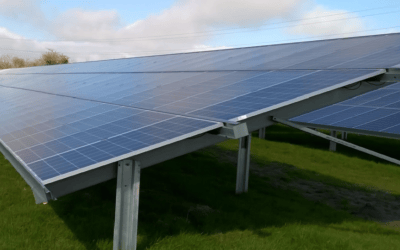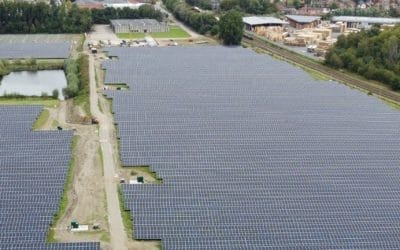As some of the most popular and well-established renewable technologies in the world, the investment case for these types of developments remains strong. Something that is further strengthened by the advancing capabilities of specialist O&M and revenue optimisation services – such as those available at Anesco – which can support investors to achieve the optimal returns from their assets.
But with governments across the globe taking action to tackle climate change and the industry itself being driven by innovation, it is likely they will be joined by many other green technologies in the future.
So, while renewables and batteries continue to lead the energy sector’s transition, what other innovations are grabbing investor attention right now?
We asked Anesco Trading Manager, Philip Wiltshire, to shine a spotlight on five additional emerging technologies, their applications and future potential.
1. Hydrogen
Hydrogen is one of the most talked about technologies of the moment. For some time now, there has been a way to convert water (H2O) into Hydrogen Fuel (H2) and Oxygen (O2) using electricity. The potential this process presents to make fuels greener is something that continues to drive a lot of interest and there are varying expectations for how hydrogen might support the green agenda.
How might it be used?
One thing being looked at is whether the national electricity grid could be supplemented by hydrogen. While this may be feasible up to a point, it would still require the use of traditional fossil fuels, unless a major investment in infrastructure is made.
What we’re more likely to see is hydrogen being used to trade surplus renewable energy internationally and gulf states looking to leverage solar generation through hydrogen in the place of oil reserves.
Domestically, hydrogen is probably most useful as a source of high temperature heat for heavy industry, such as steel production. It could be used in the place of the specific grade of coal still used almost exclusively by the steel industry, which is often seen as the last safe haven for coal in transitioning economies.
2. Gravity Storage
While it may be gaining a lot of attention at the moment, the idea behind gravity storage is actually an old one. With gravity storage, you store energy by lifting a weight with a motor and then releasing it. The weight then falls and in turn moves a pulley connected to a turbine. Such a system is most likely to be constructed in a special type of mineshaft or could even be placed within a tall building.
One company making strides in this area is Gravitricity. In early 2021, the team created electricity using gravity to generate power for the first time, at a demonstrator site in Edinburgh.
How might it be used?
The main hurdle with gravity storage is technical acceptance and ensuring the investment case adds up. As a solution it can be very efficient, typically being lower-cost than pumped hydro plants and traditional battery storage plants.
Interestingly, the technology may not have the same constraints around degradation that traditional batteries do. You cannot keep lithium-ion batteries 100% empty or full, they have to be somewhere in the middle. Gravity storage may be able to reach its maximum energy capacity and then wait for opportunities, without issue. However, potential response times mean batteries are better suited for many grid frequency and balancing services.
3. Blockchain
While not a green technology, blockchain is another innovation that continues to garner interest in this sector as a way of managing commodity transactions and information related to the energy transition.
It is usually talked about alongside cryptocurrencies and in basic terms is a type of mathematics that allows information to be easily verified but makes it very difficult to change.
For example, with bitcoin people can easily check how much of a currency or commodity somebody has but cannot change that information without the wider community agreeing to it, instead of a centralised institution. Proposed changes are called ‘blocks’ and the community is incentivised to validate correct blocks through a specific process. In bitcoin this is called ‘proof-of-work’ validation – better known as bitcoin mining – where people use energy intensive computer algorithms to find a block that fits with the rest of the blockchain and that everyone agrees with.
How might it be used?
While the benefits for energy trading are currently limited for smaller, localised markets – which tend to have regulators who people trust to keep score and arbitrate disputes – blockchain may have a place within global energy use. For example, for renewable obligations and carbon emission allowances across nations. SolarCoin is an example of a blockchain initiative that attempts to ‘tokenise’ or reward solar generation, and the wider Energy Web Chain aims to meet regulatory and operational needs within the energy market through blockchain.
However, one major hurdle is the technology’s own green credentials. The environmental impact of some blockchain solutions is currently dire, due to the sheer level of energy required by ‘miners’ and the concentration of those miners being in areas that rely heavily on coal.
4. Heat Pumps and District Heating Systems
District heating systems, which may include ground, water or air source heat pumps, work in a similar way to a fridge or freezer. They can draw in heat that is naturally occurring in the environment and use it to provide warmth for a group of homes, or a large building. In a similar fashion to a refrigerator that draws heat out of a container to provide a cool environment for food preservation.
Heat pumps run on electricity and are far more efficient than traditional heating and air-conditioning systems. Such systems are low maintenance and have low running costs, while being kinder to the environment. Combined with district-heating schemes which pool heat generations over a community instead of individual buildings, these efficiencies and emission savings can be easily shared and built upon.
How might it be used?
Decarbonising heat is one of the major challenges that needs to be overcome if we are to achieve net zero. The use of district heating systems is something that is growing in popularity, including in countries such as Norway.
Ground source heat pumps can help cut emissions from heating significantly and in relation to domestic properties, are a core part of the UK government’s 10-point plan.
One innovation currently being looked at is the potential for using former coalfields. The Coal Authority, along with several local authorities, is exploring the feasibility of capturing heat mine water that is heated by geothermal processes, and as such is constantly replenished and maintains a stable temperature.
5. Small Modular Reactors (SMRs)
A Small Modular Reactor is essentially a small nuclear power station that is generally 300 MWe equivalent or less in size. Four main options are being pursued: light water reactors, fast neutron reactors, graphite-moderated high temperature reactors and various kinds of molten salt reactors (MSRs).
These smaller reactors are seen as a much more manageable investment than big ones whose cost often rivals the capitalisation of the utilities concerned.
How might it be used?
One reason for interest in SMRs is that they can more readily slot into brownfield sites in place of decommissioned coal-fired plants.
A UK consortium, being led by manufacturer Rolls Royce, is currently working to develop an affordable power plant that generates electricity using a small modular reactor, seeing it as ‘an intelligent way to meet our future energy needs’.
In summary
The renewables industry is one that continues to be driven by innovation and solar, wind and storage technologies remain at the forefront, playing a crucial role in the evolving energy system.
New technologies are emerging that have the potential to aid the UK – and counties across the world – to transition to a low carbon, sustainable power network. Many such innovations, despite only being in the early stages of their development and facing various safety and regulatory issues, are already securing the attention of investors.
Whilst their full potential and commercial viability has yet to be proven, it is likely we will see a number of these innovations forming part of the energy system of the future.





